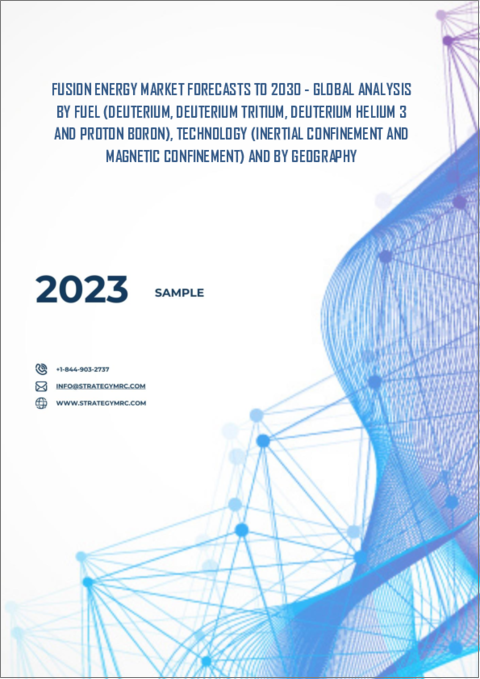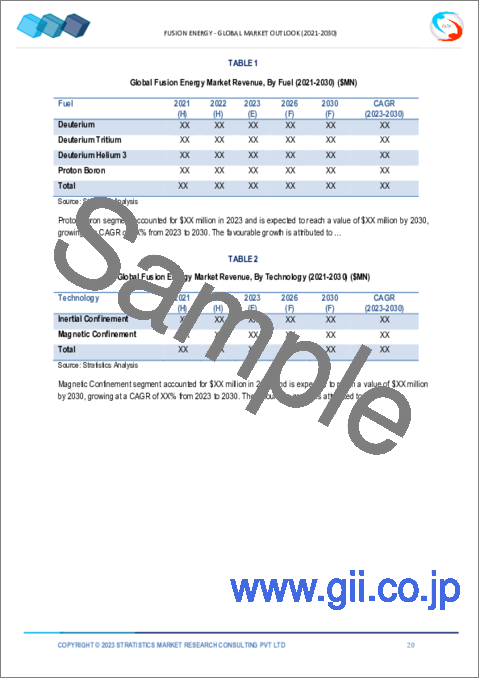|
|
市場調査レポート
商品コード
1324374
核融合エネルギー市場の2030年までの予測-燃料別、技術別、地域別の世界分析Fusion Energy Market Forecasts to 2030 - Global Analysis By Fuel (Deuterium, Deuterium Tritium, Deuterium Helium 3 and Proton Boron), Technology (Inertial Confinement and Magnetic Confinement) and By Geography |
||||||
カスタマイズ可能
|
|||||||
| 核融合エネルギー市場の2030年までの予測-燃料別、技術別、地域別の世界分析 |
|
出版日: 2023年08月01日
発行: Stratistics Market Research Consulting
ページ情報: 英文 175+ Pages
納期: 2~3営業日
|
- 全表示
- 概要
- 図表
- 目次
Stratistics MRCによると、世界の核融合エネルギー市場は2023年に3,068億米ドルを占め、予測期間中に9.4%のCAGRで成長し、2030年には5,755億米ドルに達すると予測されています。 核融合は核融合エネルギーの生産につながります。
同じことが太陽にさらされたときにも起こる。太陽は進行中の核融合によって動力を得ているため、酸素がなくてもエネルギーを発しています。今日の世界では、エネルギーは基本的な必需品です。2つ以上の軽い原子核が結合すると、膨大なエネルギーを放出する反応が生じる。プロセスの質量差の結果として、このエネルギーが生み出されます。クリーンで安全、そして環境に優しいエネルギーが生み出されます。
国際エネルギーフォーラムの記事によると、核融合は石炭・石油・ガスから生成されるエネルギーの400万倍のエネルギーを生成することができます。
市場力学:
再生可能でクリーンなエネルギー源へのニーズの高まり
化石燃料のような従来のエネルギー源が環境に与える悪影響に対する人々の意識が高まるにつれ、安全で信頼性が高く、環境に配慮した代替エネルギー源に対するニーズが高まっています。核融合エネルギーは、温室効果ガスを排出せず、半減期の長い放射性廃棄物も発生しない核融合を利用して電気を作るため、これらの要件を満たす能力を備えています。その結果、核融合エネルギー市場の研究開発への資金提供や、大規模核融合発電所の建設計画が増加しています。
核融合エネルギーに関連するリスク
核融合発電施設の安全性や運用の危険性について疑念が生じる可能性があるため、規制当局や公的認可の難しさもそのひとつです。再生可能エネルギーとの競合が激しいため、FDIは減少しており、市場拡大は、多くの場所での原子力発電部門への投資によって妨げられると予想されます。これらの要素は、核融合エネルギー技術の普及を妨げ、その商業化を先送りする可能性があります。
核融合エネルギー技術の開発と普及
もうひとつの課題は、核融合発電所の安全性やリスクに対する懸念があるため、規制当局や国民の許可を得ることです。再生可能エネルギーとの強い競争はFDIを低下させ、多くの場所で原子力発電分野への投資が市場拡大の妨げになると予測されています。これらの要因によって、核融合エネルギー技術の商業化が遅れ、広範な利用が妨げられる可能性があります。
高コストと技術的複雑性
核融合エネルギー技術の開発と導入は、高コストで技術的に複雑です。核融合プロセスを開始し維持するために、核融合エネルギーは極めて高い温度と圧力を必要とし、そのために高度な材料と複雑な工学的ソリューションが必要となります。投資家や政府の中には、核融合エネルギーを実用的なエネルギー源として追求することを、技術創成のための高額な費用と技術的複雑さのために思いとどまる者もいるかもしれないです。
COVID-19の影響
COVID-19の発生により、世界の供給ラインは大きく混乱しました。原子力産業と燃料産業の供給側と需要側の両方が、この伝染病の影響を受けた。一部の鉱山や核燃料サイクル施設が健康上の懸念から操業を停止したため、ウラン市場の供給側への影響は短期的に最も強く感じられました。しかし、利用可能な原子力発電能力を利用することで、伝染病の流行期間中、信頼できる低排出電力が供給されました。
予測期間中、重水素ヘリウム3セグメントが最大となる見込み
重水素ヘリウム3セグメントは有利な成長を遂げると推定されます。重水素ヘリウム3反応は、ヘリウムの同位体であるヘリウム3の使用を必要とします。ヘリウム3は地球上では非常に希少であるため、宇宙から採掘するか、他の核反応によって製造する必要があります。プロチウムとホウ素11の組み合わせは副反応を起こすことができるが、中性子を直接発生させることはないです。核融合の主な燃料は、より重い同位体の水素である重水素とトリチウムです。
予測期間中、CAGRが最も高くなると予想されるのは慣性閉じ込めセグメントです。
慣性閉じ込めセグメントは予測期間中に最も速いCAGRの成長が見込まれます。慣性閉じ込め装置は、イオンビームやレーザービームを使って、重水素三重水素燃料ペレットを非常に高い密度まで圧縮します。重要な閾値に達すると、衝撃波加熱によってペレットに点火します。この方法は、1秒間に数回燃料ペレットに点火できる核融合発電所を作るために使われるかもしれないです。そして、その熱で発生した蒸気をエネルギー生成タービンの動力源として利用します。
最大のシェアを占める地域:
アジア太平洋地域は、予測される世界人口の増加と新興国の経済・産業成長により、予測期間中最大の市場シェアを占めると予測されます。同地域では優れた核融合技術活動も行われています。新規競合企業の市場参入は、予測期間中の同地域の成長に大きく貢献すると思われます。
CAGRが最も高い地域:
予測期間中、欧州のCAGRが最も高いと予測されます。核融合は今世紀後半に一次エネルギー源になる可能性があり、欧州は資源が適切に管理されればその道をリードする立場にあります。この分野の開発は、核融合発電の研究を進め、新しい発電施設の建設への投資を増やすために積極的に活動している数多くの公的・商業的グループの存在によるものです。
無料カスタマイズサービス:
本レポートをご購読のお客様には、以下の無料カスタマイズオプションのいずれかを提供いたします:
- 企業プロファイル
- 追加市場プレイヤーの包括的プロファイリング(3社まで)
- 主要企業のSWOT分析(3社まで)
- 地域セグメンテーション
- 顧客の関心に応じた主要国の市場推計・予測・CAGR(注:フィージビリティチェックによる)
- 競合ベンチマーキング
- 製品ポートフォリオ、地理的プレゼンス、戦略的提携に基づく主要企業のベンチマーキング
目次
第1章 エグゼクティブサマリー
第2章 序文
- エグゼクティブサマリー
- ステークホルダー
- 調査範囲
- 調査手法
- データマイニング
- データ分析
- データ検証
- 調査アプローチ
- 調査ソース
- 一次調査情報源
- 二次調査情報源
- 前提条件
第3章 市場動向分析
- 促進要因
- 抑制要因
- 機会
- 脅威
- 技術分析
- 新興市場
- COVID-19の影響
第4章 ポーターのファイブフォース分析
- 供給企業の交渉力
- 買い手の交渉力
- 代替品の脅威
- 新規参入業者の脅威
- 競争企業間の敵対関係
第5章 核融合エネルギーの世界市場:燃料別
- 重水素
- 重水素トリチウム
- 重水素ヘリウム3
- プロトンホウ素
第6章 核融合エネルギーの世界市場:技術別
- 慣性閉じ込め
- 磁気閉じ込め
第7章 核融合エネルギーの世界市場:地域別
- 北米
- 米国
- カナダ
- メキシコ
- 欧州
- ドイツ
- 英国
- イタリア
- フランス
- スペイン
- その他欧州
- アジア太平洋
- 日本
- 中国
- インド
- オーストラリア
- ニュージーランド
- 韓国
- その他アジア太平洋地域
- 南米
- アルゼンチン
- ブラジル
- チリ
- その他南米
- 中東・アフリカ
- サウジアラビア
- アラブ首長国連邦
- カタール
- 南アフリカ
- その他中東とアフリカ
第8章 主な発展
- 契約、パートナーシップ、提携、合弁事業
- 買収と合併
- 新製品の上市
- 事業拡大
- その他の主要戦略
第9章 企業プロファイル
- General Fusion
- Helion Energy Inc.
- Kyoto Fusioneering Ltd.
- Hyperjet Fusion Corporation
- HB11 Energy Holdings Pty Ltd
- Agni Fusion Energy
- First Light Fusion
- Zap Energy Inc.
- TAE Technologies, Inc.
- Tokamak Energy Ltd.
- Marvel Fusion
- Lockheed Martin Corporation
- Commonwealth Fusion Systems
- Renaissance Fusion
- Thermonuclear Experimental Reactor(ITER)
- National Ignition Facility(NIF)
List of Tables
- 1 Global Fusion Energy Market Outlook, By Region (2021-2030) ($MN)
- 2 Global Fusion Energy Market Outlook, By Fuel (2021-2030) ($MN)
- 3 Global Fusion Energy Market Outlook, By Deuterium (2021-2030) ($MN)
- 4 Global Fusion Energy Market Outlook, By Deuterium Tritium (2021-2030) ($MN)
- 5 Global Fusion Energy Market Outlook, By Deuterium Helium 3 (2021-2030) ($MN)
- 6 Global Fusion Energy Market Outlook, By Proton Boron (2021-2030) ($MN)
- 7 Global Fusion Energy Market Outlook, By Technology (2021-2030) ($MN)
- 8 Global Fusion Energy Market Outlook, By Inertial Confinement (2021-2030) ($MN)
- 9 Global Fusion Energy Market Outlook, By Magnetic Confinement (2021-2030) ($MN)
- 10 North America Fusion Energy Market Outlook, By Country (2021-2030) ($MN)
- 11 North America Fusion Energy Market Outlook, By Fuel (2021-2030) ($MN)
- 12 North America Fusion Energy Market Outlook, By Deuterium (2021-2030) ($MN)
- 13 North America Fusion Energy Market Outlook, By Deuterium Tritium (2021-2030) ($MN)
- 14 North America Fusion Energy Market Outlook, By Deuterium Helium 3 (2021-2030) ($MN)
- 15 North America Fusion Energy Market Outlook, By Proton Boron (2021-2030) ($MN)
- 16 North America Fusion Energy Market Outlook, By Technology (2021-2030) ($MN)
- 17 North America Fusion Energy Market Outlook, By Inertial Confinement (2021-2030) ($MN)
- 18 North America Fusion Energy Market Outlook, By Magnetic Confinement (2021-2030) ($MN)
- 19 Europe Fusion Energy Market Outlook, By Country (2021-2030) ($MN)
- 20 Europe Fusion Energy Market Outlook, By Fuel (2021-2030) ($MN)
- 21 Europe Fusion Energy Market Outlook, By Deuterium (2021-2030) ($MN)
- 22 Europe Fusion Energy Market Outlook, By Deuterium Tritium (2021-2030) ($MN)
- 23 Europe Fusion Energy Market Outlook, By Deuterium Helium 3 (2021-2030) ($MN)
- 24 Europe Fusion Energy Market Outlook, By Proton Boron (2021-2030) ($MN)
- 25 Europe Fusion Energy Market Outlook, By Technology (2021-2030) ($MN)
- 26 Europe Fusion Energy Market Outlook, By Inertial Confinement (2021-2030) ($MN)
- 27 Europe Fusion Energy Market Outlook, By Magnetic Confinement (2021-2030) ($MN)
- 28 Asia Pacific Fusion Energy Market Outlook, By Country (2021-2030) ($MN)
- 29 Asia Pacific Fusion Energy Market Outlook, By Fuel (2021-2030) ($MN)
- 30 Asia Pacific Fusion Energy Market Outlook, By Deuterium (2021-2030) ($MN)
- 31 Asia Pacific Fusion Energy Market Outlook, By Deuterium Tritium (2021-2030) ($MN)
- 32 Asia Pacific Fusion Energy Market Outlook, By Deuterium Helium 3 (2021-2030) ($MN)
- 33 Asia Pacific Fusion Energy Market Outlook, By Proton Boron (2021-2030) ($MN)
- 34 Asia Pacific Fusion Energy Market Outlook, By Technology (2021-2030) ($MN)
- 35 Asia Pacific Fusion Energy Market Outlook, By Inertial Confinement (2021-2030) ($MN)
- 36 Asia Pacific Fusion Energy Market Outlook, By Magnetic Confinement (2021-2030) ($MN)
- 37 South America Fusion Energy Market Outlook, By Country (2021-2030) ($MN)
- 38 South America Fusion Energy Market Outlook, By Fuel (2021-2030) ($MN)
- 39 South America Fusion Energy Market Outlook, By Deuterium (2021-2030) ($MN)
- 40 South America Fusion Energy Market Outlook, By Deuterium Tritium (2021-2030) ($MN)
- 41 South America Fusion Energy Market Outlook, By Deuterium Helium 3 (2021-2030) ($MN)
- 42 South America Fusion Energy Market Outlook, By Proton Boron (2021-2030) ($MN)
- 43 South America Fusion Energy Market Outlook, By Technology (2021-2030) ($MN)
- 44 South America Fusion Energy Market Outlook, By Inertial Confinement (2021-2030) ($MN)
- 45 South America Fusion Energy Market Outlook, By Magnetic Confinement (2021-2030) ($MN)
- 46 Middle East & Africa Fusion Energy Market Outlook, By Country (2021-2030) ($MN)
- 47 Middle East & Africa Fusion Energy Market Outlook, By Fuel (2021-2030) ($MN)
- 48 Middle East & Africa Fusion Energy Market Outlook, By Deuterium (2021-2030) ($MN)
- 49 Middle East & Africa Fusion Energy Market Outlook, By Deuterium Tritium (2021-2030) ($MN)
- 50 Middle East & Africa Fusion Energy Market Outlook, By Deuterium Helium 3 (2021-2030) ($MN)
- 51 Middle East & Africa Fusion Energy Market Outlook, By Proton Boron (2021-2030) ($MN)
- 52 Middle East & Africa Fusion Energy Market Outlook, By Technology (2021-2030) ($MN)
- 53 Middle East & Africa Fusion Energy Market Outlook, By Inertial Confinement (2021-2030) ($MN)
- 54 Middle East & Africa Fusion Energy Market Outlook, By Magnetic Confinement (2021-2030) ($MN)
According to Stratistics MRC, the Global Fusion Energy Market is accounted for $306.8 billion in 2023 and is expected to reach $575.5 billion by 2030 growing at a CAGR of 9.4% during the forecast period. Nuclear fusion results in the production of fusion energy. The same thing occurs when exposed to the sun. The sun is powered by the ongoing nuclear fusion, which is why it emits energy even if it lacks oxygen. In today's world, energy is a basic necessity. When two or more light nuclei combine, a reaction is created that releases a huge quantity of energy. As a result of the process's mass differences, this energy is produced. Clean, secure, and ecologically friendly energy is generated.
According to an article from International Energy Forum, nuclear fusion is capable of producing energy that is 4 million times more than energy generated from coal, oil, and gas.
Market Dynamics:
Driver:
Increasing need for renewable and clean energy sources
There is an increasing need for alternative energy sources that are secure, dependable, and environmentally responsible as people become increasingly aware of the negative effects that conventional energy sources like fossil fuels have on the environment. Fusion energy has the ability to satisfy these requirements since it creates electricity by utilising nuclear fusion, which generates no greenhouse gas emissions or radioactive waste with a long half-life. As a result, there is an increase in funding for fusion energy market research and development as well as plans to construct large-scale fusion power plants.
Restraint:
Risks associated with fusion energy
The difficulty of regulatory and public approval is another one, as there can be doubts about the security and the dangers of operating fusion power facilities. Strong competition from renewable energy is reducing FDI, and market expansion is anticipated to be hampered by investments in the nuclear power sector across a number of locations. These elements might prevent fusion energy technology from becoming widely used and postpone its commercialization.
Opportunity:
Development and deployment of fusion energy technology
Another challenge is getting regulatory and public clearance because there may be concerns about the safety and risks of operating fusion power stations. Strong competition from renewable energy is lowering FDI, and it is projected that investments in the nuclear power sector in a number of places would hinder market expansion. These factors could delay the commercialization of fusion energy technology and prevent it from becoming extensively used.
Threat:
High cost and technical complexity
Fusion energy technology development and implementation are expensive and technically complex. In order to start and maintain the fusion processes, fusion energy needs extremely high temperatures and pressures, which calls for sophisticated materials and intricate engineering solutions. Some investors and governments might be discouraged from pursuing fusion energy as a practical energy source due to the high expense and technical complexity of creating the technology.
COVID-19 Impact:
Global supply lines were significantly disrupted by the COVID-19 outbreak. Both the supply and demand sides of the nuclear power and fuel industries were impacted by the epidemic. Since some mines and nuclear fuel cycle facilities stopped operating due to health concerns, the impact on the supply side of the uranium market was felt most acutely in the short term. However, the use of available nuclear power capacity provided dependable, low-emission electricity throughout the outbreak.
The deuterium helium 3 segment is expected to be the largest during the forecast period
The deuterium helium 3 segment is estimated to have a lucrative growth. The deuterium helium-3 reaction necessitates the use of helium-3, an isotope of helium that is so scarce on earth that it would have to be mined from space or produced through other nuclear reactions. The protium/boron-11 combination can yield side reactions, but it does not directly produce neutrons, which is why researchers want to use it in the future. The main fuels for nuclear fusion are the heavier isotopes of hydrogen deuterium and tritium.
The inertial confinement segment is expected to have the highest CAGR during the forecast period
The inertial confinement segment is anticipated to witness the fastest CAGR growth during the forecast period. Inertial confinement devices compress sized deuterium tritium fuels pellet to exceptionally high densities using ion or laser beams. When a crucial threshold is reached, the shock wave heating ignites the pellet. This method might be used to create a fusion power plant that could ignite fuel pellets several times per second. The steam produced by the heat is then used to power energy-generating turbines.
Region with Largest share:
Asia Pacific is projected to hold the largest market share during the forecast period owing to projected global population growth as well as the economic and industrial growth of developing countries. Excellent nuclear fusion technology activities are also being carried out in the region. The entry of new competitors joining the market is likely to contribute significantly to the region's growth over the forecast period.
Region with highest CAGR:
Europe is projected to have the highest CAGR over the forecast period. Nuclear fusion could become the primary source of energy in the second half of this century, and Europe is well-positioned to lead the way if its resources are managed properly. The development of this area is credited to the existence of numerous public and commercial groups that are actively working to advance fusion power research and increase investments in the construction of new power facilities.
Key players in the market:
Some of the key players profiled in the Fusion Energy Market include: General Fusion, Helion Energy Inc., Kyoto Fusioneering Ltd., Hyperjet Fusion Corporation, HB11 Energy Holdings Pty Ltd, Agni Fusion Energy, First Light Fusion, Zap Energy Inc., TAE Technologies, Inc., Tokamak Energy Ltd., Marvel Fusion,, Lockheed Martin Corporation, Commonwealth Fusion Systems, Renaissance Fusion, Thermonuclear Experimental Reactor (ITER) and National Ignition Facility (NIF).
Key Developments:
In May 2023, Helion Energy (Helion) today announced an agreement to provide Microsoft electricity from its first fusion power plant. Constellation will serve as the power marketer and will manage transmission for the project.
In November 2022, Canadian Nuclear Laboratories (CNL) and General Fusion announced that they have signed a Memorandum of Understanding (MOU) to pursue a series of joint projects to accelerate the deployment of commercial fusion power in Canada.
Fuels Covered:
- Deuterium
- Deuterium Tritium
- Deuterium Helium 3
- Proton Boron
Technologies Covered:
- Inertial Confinement
- Magnetic Confinement
Regions Covered:
- North America
- US
- Canada
- Mexico
- Europe
- Germany
- UK
- Italy
- France
- Spain
- Rest of Europe
- Asia Pacific
- Japan
- China
- India
- Australia
- New Zealand
- South Korea
- Rest of Asia Pacific
- South America
- Argentina
- Brazil
- Chile
- Rest of South America
- Middle East & Africa
- Saudi Arabia
- UAE
- Qatar
- South Africa
- Rest of Middle East & Africa
What our report offers:
- Market share assessments for the regional and country-level segments
- Strategic recommendations for the new entrants
- Covers Market data for the years 2021, 2022, 2023, 2026, and 2030
- Market Trends (Drivers, Constraints, Opportunities, Threats, Challenges, Investment Opportunities, and recommendations)
- Strategic recommendations in key business segments based on the market estimations
- Competitive landscaping mapping the key common trends
- Company profiling with detailed strategies, financials, and recent developments
- Supply chain trends mapping the latest technological advancements
Free Customization Offerings:
All the customers of this report will be entitled to receive one of the following free customization options::
- Company Profiling
- Comprehensive profiling of additional market players (up to 3)
- SWOT Analysis of key players (up to 3)
- Regional Segmentation
- Market estimations, Forecasts and CAGR of any prominent country as per the client's interest (Note: Depends on feasibility check)
- Competitive Benchmarking
- Benchmarking of key players based on product portfolio, geographical presence, and strategic alliances
Table of Contents
1 Executive Summary
2 Preface
- 2.1 Abstract
- 2.2 Stake Holders
- 2.3 Research Scope
- 2.4 Research Methodology
- 2.4.1 Data Mining
- 2.4.2 Data Analysis
- 2.4.3 Data Validation
- 2.4.4 Research Approach
- 2.5 Research Sources
- 2.5.1 Primary Research Sources
- 2.5.2 Secondary Research Sources
- 2.5.3 Assumptions
3 Market Trend Analysis
- 3.1 Introduction
- 3.2 Drivers
- 3.3 Restraints
- 3.4 Opportunities
- 3.5 Threats
- 3.6 Technology Analysis
- 3.7 Emerging Markets
- 3.8 Impact of Covid-19
4 Porters Five Force Analysis
- 4.1 Bargaining power of suppliers
- 4.2 Bargaining power of buyers
- 4.3 Threat of substitutes
- 4.4 Threat of new entrants
- 4.5 Competitive rivalry
5 Global Fusion Energy Market, By Fuel
- 5.1 Introduction
- 5.2 Deuterium
- 5.3 Deuterium Tritium
- 5.4 Deuterium Helium 3
- 5.5 Proton Boron
6 Global Fusion Energy Market, By Technology
- 6.1 Introduction
- 6.2 Inertial Confinement
- 6.3 Magnetic Confinement
7 Global Fusion Energy Market, By Geography
- 7.1 Introduction
- 7.2 North America
- 7.2.1 US
- 7.2.2 Canada
- 7.2.3 Mexico
- 7.3 Europe
- 7.3.1 Germany
- 7.3.2 UK
- 7.3.3 Italy
- 7.3.4 France
- 7.3.5 Spain
- 7.3.6 Rest of Europe
- 7.4 Asia Pacific
- 7.4.1 Japan
- 7.4.2 China
- 7.4.3 India
- 7.4.4 Australia
- 7.4.5 New Zealand
- 7.4.6 South Korea
- 7.4.7 Rest of Asia Pacific
- 7.5 South America
- 7.5.1 Argentina
- 7.5.2 Brazil
- 7.5.3 Chile
- 7.5.4 Rest of South America
- 7.6 Middle East & Africa
- 7.6.1 Saudi Arabia
- 7.6.2 UAE
- 7.6.3 Qatar
- 7.6.4 South Africa
- 7.6.5 Rest of Middle East & Africa
8 Key Developments
- 8.1 Agreements, Partnerships, Collaborations and Joint Ventures
- 8.2 Acquisitions & Mergers
- 8.3 New Product Launch
- 8.4 Expansions
- 8.5 Other Key Strategies
9 Company Profiling
- 9.1 General Fusion
- 9.2 Helion Energy Inc.
- 9.3 Kyoto Fusioneering Ltd.
- 9.4 Hyperjet Fusion Corporation
- 9.5 HB11 Energy Holdings Pty Ltd
- 9.6 Agni Fusion Energy
- 9.7 First Light Fusion
- 9.8 Zap Energy Inc.
- 9.9 TAE Technologies, Inc.
- 9.10 Tokamak Energy Ltd.
- 9.11 Marvel Fusion
- 9.12 Lockheed Martin Corporation
- 9.13 Commonwealth Fusion Systems
- 9.14 Renaissance Fusion
- 9.15 Thermonuclear Experimental Reactor (ITER)
- 9.16 National Ignition Facility (NIF)






